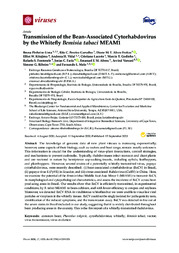Transmission of the bean-associated Cytorhabdovirus by the whitefly Bemisia tabaci MEAM1.
Transmission of the bean-associated Cytorhabdovirus by the whitefly Bemisia tabaci MEAM1.
Authorship: PINHEIRO-LIMA, B.; PEREIRA-CARVALHO, R. C.; ALVES-FREITAS, D. M. T.; KITAJIMA, E. W.; VIDAL, A. H.; LACORTE, C.; GODINHO, M. T.; FONTENELE, R. S.; FARIA, J. C.; ABREU, E. F. M.; VARSANI, A.; RIBEIRO, S. G.; MELO, F. L.
Summary: The knowledge of genomic data of new plant viruses is increasing exponentially; however, some aspects of their biology, such as vectors and host range, remain mostly unknown.This information is crucial for the understanding of virus?plant interactions, control strategies,and mechanisms to prevent outbreaks. Typically, rhabdoviruses infect monocot and dicot plantsand are vectored in nature by hemipteran sap-sucking insects, including aphids, leafhoppers,and planthoppers. However, several strains of a potentially whitefly-transmitted virus, papayacytorhabdovirus, were recently described: (i) bean-associated cytorhabdovirus (BaCV) in Brazil,(ii) papaya virus E (PpVE) in Ecuador, and (iii) citrus-associated rhabdovirus (CiaRV) in China. Here,we examine the potential of theBemisia tabaciMiddle East-Asia Minor 1 (MEAM1) to transmit BaCV,its morphological and cytopathological characteristics, and assess the incidence of BaCV across beanproducing areas in Brazil. Our results show that BaCV is efficiently transmitted, in experimentalconditions, byB. tabaciMEAM1 to bean cultivars, and with lower efficiency to cowpea and soybean.Moreover, we detected BaCV RNA in viruliferous whiteflies but we were unable to visualize viralparticles or viroplasm in the whitefly tissues. BaCV could not be singly isolated for pathogenicity tests,identification of the induced symptoms, and the transmission assay. BaCV was detected in five out ofthe seven states in Brazil included in our study, suggesting that it is widely distributed throughoutbean producing areas in the country. This is the first report of a whitefly-transmitted rhabdovirus.
Publication year: 2020
Types of publication: Journal article
Unit: Embrapa Rice & Beans
Keywords: Bemisia Tabaci, Common bean, Feijão, Mosca Branca, Phaseolus Vulgaris, Vector, Vetor, Virus evolution, Vírus, Whitefly
Observation
Some of Embrapa's publications are published as ePub files. To read them, use or download one of the following free software options to your computer or mobile device. Android: Google Play Books; IOS: iBooks; Windows and Linux: Calibre.
Access other publications
Access the Agricultural Research Database (BDPA) to consult Embrapa's full library collection and records.
Visit Embrapa Bookstore to purchase books and other publications sold by Embrapa.

